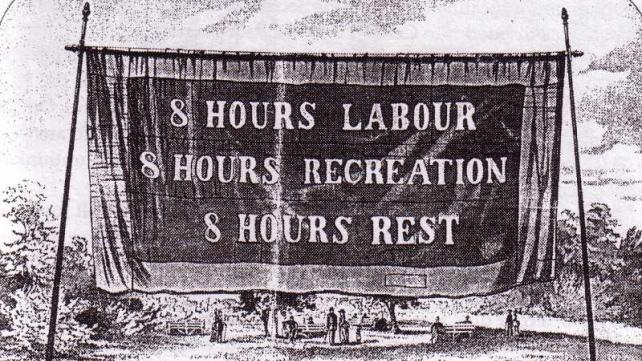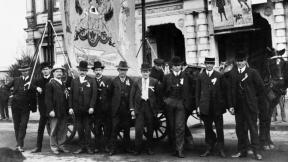
Labor Day in the United States is the first Monday in September. For many Muslims, it marks the last of the summer national conferences. In American culture it is regarded as a day that marks the end of summertime activities like swimming, backyard barbecues or even wearing white colored clothing. It has a seriousness attached to it as it signals the return to school and “work”.
The website of the United States Department of Labor describes this day as “a creation of the labor movement and …a dedication to the social and economic achievements of American workers.” This particular description is by no means thorough in explaining the full nature of this particular American observance.
Labor Day as a holiday was long in coming and its history is dramatic, complex, and frankly, bloody. In the late 1800s America’s workers began to demand an eight-hour workday. At that time in history, employees did not automatically enjoy safe working conditions or fair hiring, firing, and grievance procedures. Workers did not have sick or vacation leave and the average workweek was over 60 hours. In response to these unfair labor practices, workers united and formed labor unions.
But even labor unions were marred by corruption and racism that gripped the U.S. Labor unions as a practice excluded African Americans, Chinese, Mexicans, Catholics and immigrants from some parts of Europe. “Native Protestants” was a label that Northern white males gave themselves in order to distinguish themselves from white immigrants and signify that they were America born and raised.
For African-Americans, after the Civil War, many migrated to the north looking for low skilled manufacturing and factory jobs. The railroad industry provided many opportunities of employment for African-Americans in the late 19th century and early 20th century. But the “Native Protestants” saw the influx of African-American workers as a threat and feared they would steal jobs away, since they would be forced to work longer hours for lower pay. Thus, many of these white men joined or created labor unions that constitutionally banned not only African-Americans, but Catholics and other ethnic minorities as well. African-American workers were forced to create their own unions, like the Pullman Porters.
There were many incidents leading up to the creation of this holiday. Throughout the 1880’s labor strikes were a repeated occurrence. In May of 1886, the growing problems between labor and management boiled over. The labor movement had set May 1 as the date they wanted the industries they worked for to comply with their demands. Their rally cry was “Eight hour day with no cut in pay.” On May 3 of that year in Chicago, a peaceful strike turned violent with police firing into the crowd and killing two strikers. The next night at Chicago’s Haymarket Square, the violence increased exponentially into a riot that left one policeman dead, four additional workers dead, six police officers mortally wounded, and many injured.
Eight of the labor protesters were arrested for killing the policeman. The media and anti-immigrant sentiments hyped the situation further, as some of the accused were German immigrants, although the leader of the rebellion was actually a Confederate soldier. Seven of the men were sentenced to death, four were hung, and one committed suicide before his hanging. Six years later the governor of Illinois pardoned the remaining three men and labeled them victims of "hysteria, packed juries, and a biased judge,".
The national and international reaction to what became known as the “Haymarket Massacre” and the resulting trial led to May 1 becoming International Workers Day in 1890, which is celebrated worldwide.
After the Haymarket Massacre, in 1893 during the recession, Chicago industrialist George Pullman cut his labor workforce by over 30 percent by laying off hundreds of employees, as well as making deep wage cuts for many of the remaining workers. In addition, he refused to lower rents or store prices in his company’s town, Pullman, Illinois which was where his laborers worked and rented lodgings.
Angry and financially distraught employees staged a strike in May of 1894. The American Railway Union boycotted all trains using Pullman cars as a show of support. This Pullman strike was powerful because it basically halted rail traffic and commerce in 27 states from Chicago all the way to the West Coast. Businesses were forced to ask for help from the federal government to shut the strike down so they would stop losing so much money.
Then President Grover Cleveland responded by ordering federal troops to the city to enforce an injunction for the rail workers to return to their jobs. When the federal troops arrived, the Pullman strike spiraled out of control. Rioting ensued with rioters destroying hundreds of railroad cars in South Chicago. The national guard responded to these threats by shooting into the crowd and killing 30 people.
Even before this railway strike, the President and Congress were aware that the labor problems in the U.S. were getting out of hand and they sympathized with the workers. They recognized that the problem was worldwide and sought to have a solution that was distanced from the unfortunate events of the Haymarket Massacre a few years earlier. In June of 1894, as the Pullman Company and railroad workers were still in the midst of their strike, Congress passed legislation making the first Monday in September a federal legal holiday to recognize and celebrate the contributions of America’s laborers.




Comments
Labor Day
I loved this honest version of the facts. Celebrating Labor Day on a date different from the rest of the world is like trying to disguise the facts, hide real history. You can't hide the sun with a finger. All the benefits that the world's workers enjoy were achieved, and are still being achieved, thanks to the sacrifices of those who risk and even lose their lives in protests for fair labor agreements.
Location
Add new comment